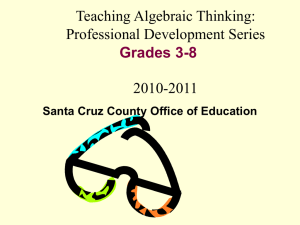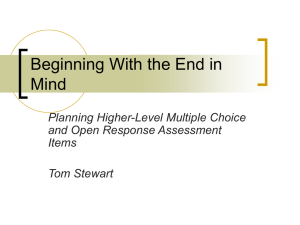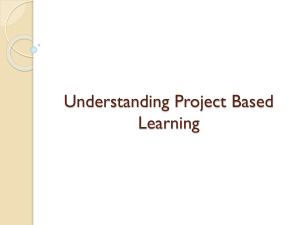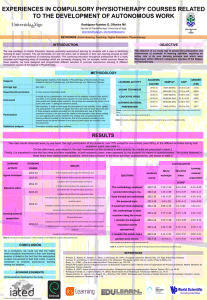اضغط هنا
advertisement
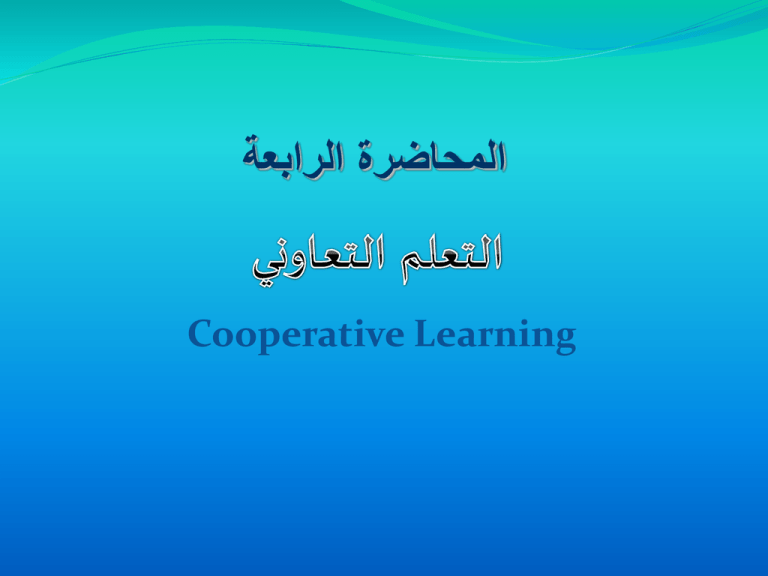
المحاضرة الرابعة Cooperative Learning مقدمة التعليم التعاوني Cooperative Education التعلم التعاوني Cooperative Learning ماهو التعلم التعاوني؟ لماذا التعاون يزيد من التحصيل والدافعية للتعلم. لماذا تنجح األعمال الجماعية أكثر من الفردية؟ ماهي خصائص الشخصية السوية؟ كيف يتعامل األقران من أجل التعلم؟. ماهو التعلم التعاوني العمل كمجموعة التعلم من األقران حجم المجموعات إيجاد جو التنافس اإلعداد الجيد المعلم موجه. الدعوة للتعاون التعاون على الخير حب االجتماع ونبذ التفرق حب الجماعة ونبذ الفردية. يستمتع ويتعلم التالميذ من أقرانهم أكثر منه من معلمهم! التعاون يؤدي إلى زيادة التعلم التنافس هو السر الخفي وراء الحافز للتعلم. يرى بياجيه أن: النضج والتجارب النشطة والتقبل االجتماعي واالنضباط الشخصي... وسائل فائقة للنمو العقلي طرد الشعور بالوحدة والعزلة االجتماعية. تنمية الشخصية االجتماعية الفاعلة احترام الرأي اآلخر التعارف بين التالميذ تنمية العمل الجماعي ومحبة العمل مع اآلخرين العالقات االجتماعية وسائل فائقة للنمو العقلي. الرابعة • اإلنهاء • االنتاجية الثالثة الثانية • بلورة معايير العمل • التعرف األولى تنظيم التعلم التعاوني تنظيم المجموعات المجموعات الفاعلة تنظيم التفاعل بين التالميذ التفاعل اللفظي والتفاعل العملي مهارات جمع المعلومات تلخيص العمل. حجم المجموعات المجموعات الكبيرة المجموعات الصغيرة األزواج المجموعات الدائمة المجموعات المتغيرة المجموعات المشكلة. األسئلة الخمسة: -1ماذا أعرف؟ -2ماذا أريد أن أعرف؟ -3كيف سأتعلم ،وكيف سأعمل مع اآلخرين؟ -4ماذا تعلمت؟ -5كيف تعاونت ،وماذا تعلمت مع اآلخرين؟. أدوار المعلم في التعلم التعاوني اإلعداد الجيد قبل الدرس تخطيط الدرس جدولة العمل إعداد األدوات إعداد البيئة توزيع المجموعات تقديم الدرس متابعة عمل المجموعات المراجعة الدائمة وإعطاء التعليمات التحرك بين المجموعات مناقشة المجموعات تقويم عمل المجموعات والدرس غلق الدرس. مهارات التحرك مهارات الجلوس مهارات التحدث بصوت منخفض مهارات المشاركة والتعريف باالهتمامات مهارات اإليجابية نحو اآلخرين مهارات تعليم إشارات السكوت مهارات األسئلة العميقة مهارات استنباط العالقات بين األشياء مهارات معارضة األفكار ال األشخاص مهارات توسيع األفكار مهارات دمج األفكار. ؟ تحليل التعلم التعاوني حديث المعلم لكل الفصل حديث المعلم لكل مجموعة مناقشة المعلم لكل مجموعة حديث كل تلميذ مع المعلم حديث التلميذ مع المجموعة حديث التلميذ مع التلميذ الصمت الفوضى. -1عدم وضوح الفرق بين المجموعات التقليدية والمجموعات التعاونية -2العزلة التي يتبناها أكثر المربين -3مقاومة التغيير -4الجهد الكبير في اإلعداد والتخطيط للتدريس التعاوني. Using the Jigsaw method … You self-selected into “expert groups” Expert groups were given a learning task which involved participating in different workshops Expert groups now work together (9.30-10.30) New groups will be formed and experts will teach each other what they learned (10.4511.30) There will be some check to see if the intended learning outcomes were achieved (11-30-11.45) Expert groups: Sharing information Question by question Compare your responses, agree on salient points and examples Your data In relation to the topic, what might a new teacher (i) know and (ii) be able to do from attending this workshop? What teaching methods and activities did the academic developer use? How would you describe the relationship between the academic developer and the participants? Anything else that “strikes” you? Plan your strategy for teaching your colleagues who attended other classes (15 mins teaching including questions) Teaching others Form into new groups to teach each other what you learned in the workshop and discussed in your expert group Follow this schedule … (15 minutes) … (15 minutes) Teacher is the time keeper … (15 minutes) If you finish in less than15 minutes, wait until you are given the signal to move onto the next topic Learning check About the content Any “lessons” about preparing, supporting and working with new staff? Your questions Anything still unanswered? Co-operative learning Five elements: 1. Clearly perceived positive interdependence (sink or swim together) 2. Individual accountability 3. Face-to-face interaction 4. Individual and small group skills 5. Group processing Students advance their own and each others’ learning Potential outcomes… Academic benefits Increased academic achievement More academic discussion outside of the classroom Longer information retention Better higher level reasoning Better understanding of alternative viewpoints Improved critical thinking Higher motivation Skills for employment & life Improved social & communication skills Better teamwork skills Leadership practise Independent learning skills Jigsaw is a Co-operative Learning Method. The class is divided into groups Groups are given different learning tasks and plan what needs to be done to complete the task Work is done either in or out of class New groups are formed and group members teach each other what they have learned Some check is put in place to ensure accurate understanding Read Ledlow’s article for more detail Using Jigsaw, Example 1 Short course: 10 Activities to Get Students to Talk in Class Intended learning outcomes Participants learn how to use the Jigsaw in their own classes Participants learn different ways to get students to ask and answer questions Time frame: About 45 minutes Jigsaw, Example 1 Step 1: Form expert groups 1. Remember the number you are given 1 2 3 1 2 3 1 2 3 1 2 3 2. Form groups with other participants who have the same number as you v 1111 2222 3333 Jigsaw, Example 1 Step 2: Introductions and preparation If you have not already met, take turns to introduce yourself to your group Read the activity you have been given In the next 10 minutes Make sure you each understand the activity/activities that have been described Decide whether you think it would be useful to use with students at your College Come up with any suggestions for improvement 1111 2222 3333 Jigsaw, Example 1 Step 3: Learning from each other Form into new groups (diagram) 123 123 123 123 Drawing on the discussion within your last group, take turns to: Explain your activity to your new group Give your previous group’s opinion on (i) its usefulness (ii) suggestions for improvement (5 mins with questions… Adele is the timekeeper) Follow this order (i) Group 1 (ii) Group 2 (iii) Group 3 Jigsaw, Example 1 Step 4: Check on learning Five “volunteers” to finish any one of these stems… The activity that would be most useful to me… Something I have been thinking about in relation to the way I typically ask questions… I don’t think [activity] would work with my class because…. The most important learning I got from this exercise is…. Jigsaw, Example 2 Step 1: Form expert groups Form groups with other students who have a task sheet that is the same colour as yours. No more than 6 in a group. Jigsaw, Example 2 Step 2: Introduce yourselves if you have not already met Read your task sheet and agree with your group members about: What needs to be done Who will do it Ask Teacher for help if you need it. Jigsaw, Example 2 Reviewing the “Jigsaw” using a “Round”.. Since we started on this TLA (teaching and learning activity), what skills have been required of you? Jigsaw, Example 2 Steps… 1. 2. 3. Divide class into groups Groups plan what needs to be done Out of class work and coming up 4. Share and organise information in your ‘expert’ groups 5. Share information with others in the class Jigsaw, Example 2 Step 4: Sharing and synthesising your research Share with your expert group what you have learned from your overnight research Plan and prepare an A3 Poster (photocopies for each group member will be made) that captures your learning (1hr 15mins) (LATER, each group member will present their research/poster to another group) Jigsaw, Example 2 Reviewing the “Jigsaw” so far… 1. A question I have …. 2. Something that bothers me … 3. A skill that was demanded in Step 4… gsaw, Example 2 Step 5: Teaching others Ji Form into new groups to teach each other what you learned in your expert group Follow this schedule … (0-15) …. (15-30) Teacher is the time keeper … (30-45) …. (45-60) If you finish in less than15 minutes, wait until you are given the signal to move onto the next Jigsaw, Example 2 Reviewing the “Jigsaw” Reactions to Step 5? Jigsaw, Example 2 Step 7: Learning check Instructions: Step 1: By yourself, complete the test (there may be more than one correct answer for each question) (about 5 minutes) Step 2: Reassemble into your “expert” team, appoint a “recorder”, and compare your answers Step 3: The recorder places the team’s answers on the whiteboard once agreement is reached. Step 4: The recorder will be advised if there is an incorrect answer. In this case, teams must renegotiate answers. Resource documents can be used in second and successive attempts to “pass” the test. gsaw, Example 2 Step 7: alternative Learning check Ji About the content The most important thing you have learned about services and resources? About the process Might you use it in your own classes? If so, what topic and how might you adapt it? نشاط جماعي من 8 -5دقائق طبقي نموذج جيكسوفي تدريس مفهوم علمي تختارينه v v v Using “The Fishbowl” to share experiences Discussion activity suitable for large groups Allows the whole group to participate in one conversation and share, listen to, and critique viewpoints and experiences Eliminates reporting back Leading Academic Development, Adele Graham Leading Academic Development, o2/o8, Adele Graham (02/08) Fishbowl instructions Four volunteers to start the discussion “Academic Development in Saudi Arabia” (notes as prompts) Participants who are outside the fishbowl may want to contribute their experiences/views to the conversation or ask a question. They can do so by taking up the empty chair When the empty chair becomes occupied, someone already in the fishbowl must leave If you are inside the fishbowl and want to leave, you can do so by tapping-in someone outside the fishbowl to take your place CAD staff who have a question can take up the empty-chair but leave when it is addressed. Noone leaves ifto CAD joins. If you do not join the fishbowl, beDevelopment, ready provide a summary of the discussion Leading Academic Adele Graham (02/08)Academic Development, o2/o8, Adele Graham Leading نشاط جماعي من 8 -5دقائق طبقي نموذج حوض السمك في تدريس مفهوم علمي تختارينه



